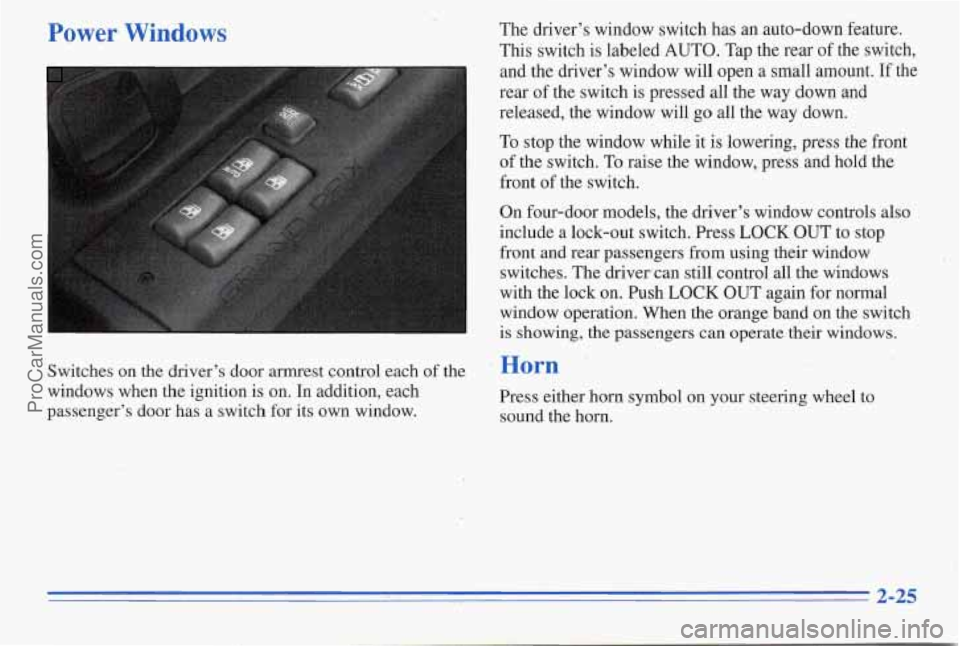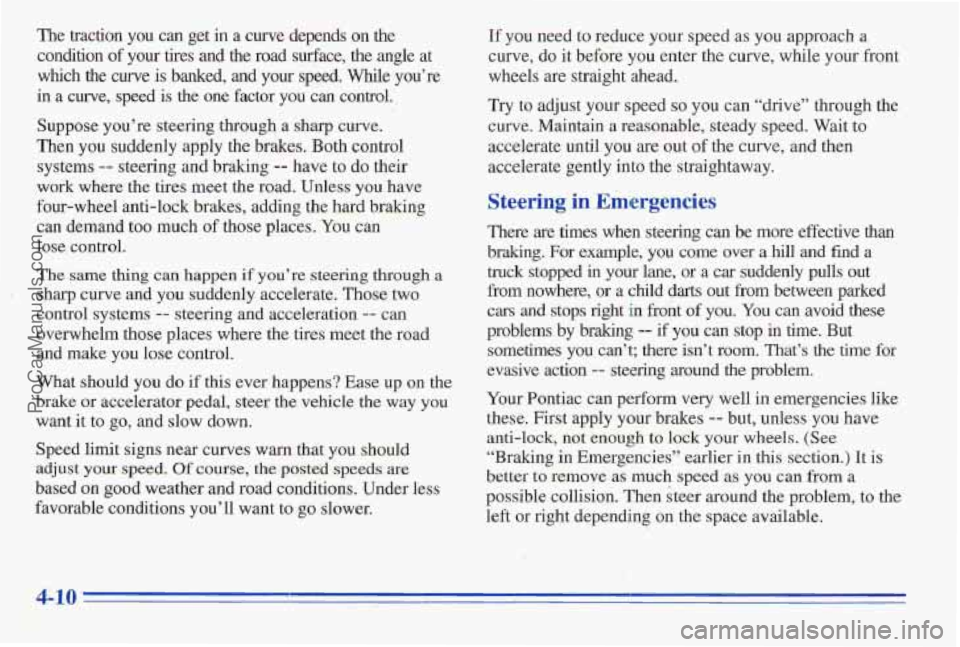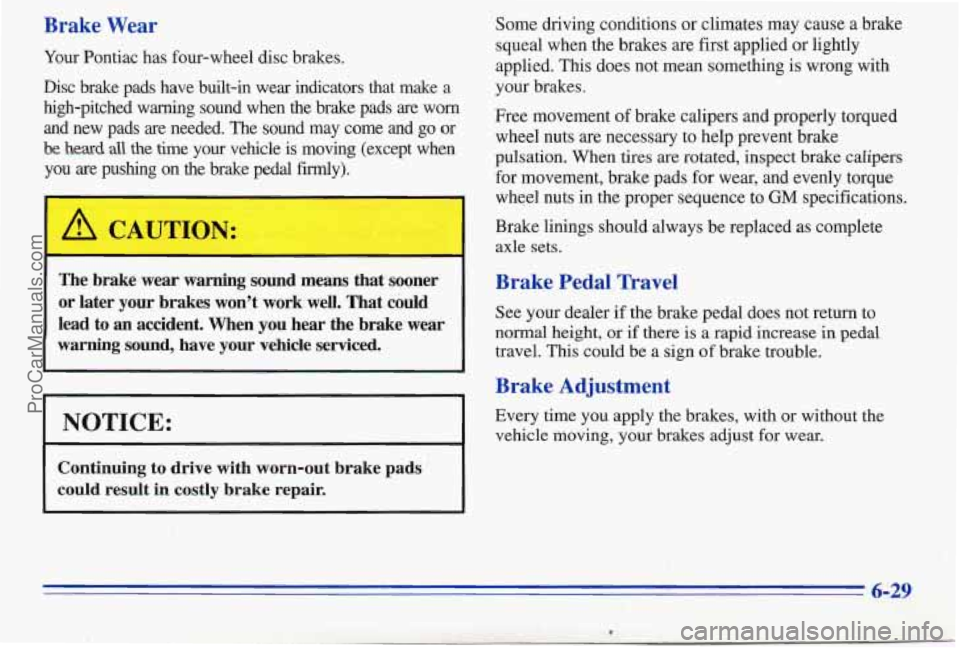1996 PONTIAC PONTIAC four wheel drive
[x] Cancel search: four wheel drivePage 94 of 370

Power Windows The driver's window switch has an auto-down feature.
This switch is labeled AUTO. Tap the rear of the switch,
and the driver's window will open
a small amount. If the
rear of the switch is pressed all the way down and
released, the window will
go all the way down.
To stop the window while it is lowering,
press the front
of the switch.
To raise the window, press and hold the
front
of the switch.
.. . ._ 1 , ..1; 'T On four-door models, the driver's window controls also
7; include a lock-out switch. Press LOCK OUT to stop
. >. -. c with the lock on. Push LOCK OUT again for normal
. ., .I -. .. front and rear passengers from using their window . switches. The drivercan still control all the windows .- ..
. 5' .. .. window operation. When the orange band on the switch
is showing, the passengers can operate their windows.
Switches on
the driver's door armrest control each of the . Horn
windows when the ignition is on. In addition, each
Press either horn symbol on your steering wheel to
passenger's door has a switch for its own window.
sound the horn.
2-25
ProCarManuals.com
Page 165 of 370

The traction you can get in a curve depends on the
condition of your tires and the road surface, the angle at
which
the curve is banked, and your speed. While you’re
in a curve, speed is the one factor you can control.
Suppose you’re steering through a sharp curve.
Then you suddenly apply the brakes. Both control
systems
-- steering and braking -- have to do ~eir
work where the tires meet
the road. Unless you have
four-wheel anti-lock brakes, adding
the hard braking
can demand too much of those places. You can
lose control.
The same thing can happen if you’re steering through a
sharp curve and you suddenly accelerate. Those two
control systems
-- steering and acceleration -- can
overwhelm
those places where the tires meet the road
and make you lose control.
What should you do
if this ever happens? Ease up on the
brake or accelerator pedal, steer the
vehicle the way you
want it to
go, and slow down.
Speed limit signs near curves warn that you should
adjust your
speed, Of course, the posted speeds are
based on good weather and road conditiolls. Under less
favorable conditions you’ll want to go slower.
If you need to reduce your speed as you approach a
curve, do it b’efore you enter the curve, while your front
wheels are straight ahead.
Try to adjust your speed so you can “drive” through the
curve. Maintain a reasonable, steady speed. Wait to
accelerate until you
are out of the curve, and then
accelerate gently into the straightaway.
Steering in Emergencies
There are times when steering can be more effective than
braking. For example, you come over
a hill and find a
truck stopped
in your lane, or a car suddenly pulls out
from nowhere, or a child darts out from between parked
cars and stops right in front of you. You can avoid these
problem
by braking -- if you can stop in time. But
sometimes you,can’t; there isn’t room. That’s the time for
evasive action
-- steering around the problem.
Your Pontiac can perform very well in emergencies like
these. First apply your brakes
-- but, unless you have
anti-lock, not enough
to lock your wheels. (See
“Braking in Emergencies” earlier in this section.) It
is
better t’o remove as much speed as you can from a
possible collision. Then steer around
the problem, to -the
left ‘or right depending on the space available.
I’ . , .I ,. ’ .~
.. . . ,.- , . . .. .
. .. :.
. . - I 1-.. -’ . ..
ProCarManuals.com
Page 186 of 370

four vehicle can tow a trailer. To identify what the
vehicle trailering capacity is for your vehicle, you
should read the information
in “Weight of the Trailer”
that appears later in this section. But trailering is
different than just driving your vehicle by itself.
Trailering means changes in handling, durability, and
fwl economy. Successful, safe trailering takes correct
equipment, and
it has to be used properly.
That’s the reason for this part. In it are many
time-tested, important trailering tips and safety rules.
Many of these are important for your safety and that
of
your passengers. So please read this section carefully
before you pull
a trailer.
Load-pulling components such as the engine, transaxle,
wheel assemblies and tires are forced to work harder
against the drag
of the added weight. The engine is
required to operate at relatively higher speeds and under
greater loads, generating extra heat. What’s more, the
trailer adds considerably to wind resistance, increasing
the pulling requirements.
If You Do Decide To Pull A Trailer
If you do, here are some important points:
0
0
0
0
0
There are many different laws, including speed limit
restrictions, having
to do with trailering. Make sure
your rig will be legal, not only where you live but
also where you’ll be driving.
A good source fa this
information can be state or provincial police.
Consider using
a sway control. You can ask a hitch
dealer about sway controls.
Don’t tow a trailer
at all during the first 1,000 miles
(1 600 km) your new vehicle is driven. Your engine,
axle
or other parts could be damaged.
Then, during the
fkst 500 miles (800 km) that you tow
a trailer, don’t drive
over 50 mph (80 km/h) and don’t
make starts at
full throttle. This helps your engine and
other parts
of your vehicle wear in at the heavier loads.
Obey speed limit restrictions when towing a trailer.
Don’t drive faster than the maximum posted speed
for trailers (or no more than
55 mph (90 km/h)) to
save wear on your vehicle’s parts.
Three important considerations have to do with weight:
the weight of the trailer,
0 the weight of the trailer tongue
0 and the total weight on your vehicle’s tires.
4-31
ProCarManuals.com
Page 256 of 370

Brake Wear
Your Pontiac has four-wheel disc brakes.
Disc brake pads have built-in wear indicators that make a
high-pitched warning sound when the brake pads
are worn
and new pads
are needed. The sound may come and go or
be heard all the time your vehicle is moving (except when
you are pushing on the brake pedal
fldy).
The brake wear warning sound means that sooner
or later
your brakes won't work well. That could
lead to an accident. When you hear the brake wear
warning sound, have
your vehicle serviced.
I NOTICE:
Continuing to drive with worn-out brake pads
could
result in costly brake repair.
Some driving conditions or climates may cause a brake
squeal when the brakes are first applied or lightly
applied. This does not mean something
is wrong with
your brakes.
Free movement
of brake calipers and properly torqued
wheel nuts are necessary to help prevent brake
pulsation. When tires are rotated, inspect brake calipers
for movement, brake pads for wear, and evenly torque
wheel nuts in the proper sequence to
GM specifications.
Brake linings should always be replaced as complete
axle sets.
Brake Pedal navel
See your dealer if the brake pedal does not return to
normal height,
or if there is a rapid increase in pedal
travel. This could be a sign
of brake trouble.
Brake Adjustment
Every time you apply the brakes, with or without the
vehicle moving, your brakes adjust for wear.
6-29
ProCarManuals.com